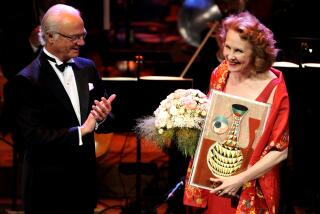Taking a Cue From the Past
- Share via
The jazz ‘90s were largely dominated by young artists captivated by the bop and hard bop ‘50s and ‘60s--a kind of neo-jazz classicism. So it’s probably not surprising that the first decade of the new millennium seems to be taking the influence pattern a decade further, with a growing number of artists looking closely at the avant-garde ‘60s and early ‘70s.
Japanese pianist Satoko Fujii, who made a far-too-brief visit to Los Angeles on Saturday night via an appearance at Rocco’s, is one of the outstanding voices in a new movement that includes such musicians as Dave Douglas, Andy Milne, John Zorn and Cuong Vu. Working with a quartet that included her husband, trumpeter Natsuki Tamura, bassist Takeharu Hayakawa and drummer Tatsuya Yoshida, she performed a set that included only two tunes--each a stretched version of her highly exploratory, remarkably colorful, improvisationally based music.
Fujii’s most appealing compositional asset is her capacity to organize her music in atmospherically dramatic fashion. In one of the works, “Toward to West,” the mood shifted in slowly evolving fashion, from wildly percussive rhythms to pensive harmonic passages. The soloing, mostly handled by Fujii and Tamura, was deeply reminiscent of ‘60s styles. Echoes of Cecil Taylor surged through Fujii’s often violent attacks upon the keyboard, while Tamura’s passages--sometimes in completely a cappella segments--possessed the sort of humor and imagination typical of the trumpet work of the late Don Ellis.
It’s easy to level the same sort of criticism at the ‘60s revivalists that was leveled at the original practitioners, of course: The music is just the product of a bunch of fingers randomly thrown at keys; it doesn’t require any traditional musical skills. And there’s some truth to the criticism, in terms of both past and present decades.
But Fujii--like many of the younger artists--is a well-trained musician, who also seems tapped into contemporary pop and rock music, not hesitating to cross over into those areas during passages within her larger works. Which probably explains why her edgy, intrepid music appeals to younger audiences who are far more resistant to the jazz sounds of the ‘50s. Call it an interesting trend in the making.
More to Read
The biggest entertainment stories
Get our big stories about Hollywood, film, television, music, arts, culture and more right in your inbox as soon as they publish.
You may occasionally receive promotional content from the Los Angeles Times.







